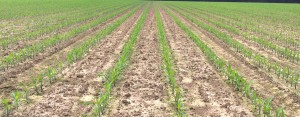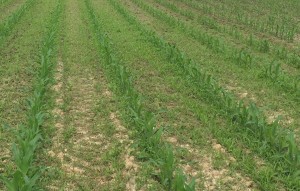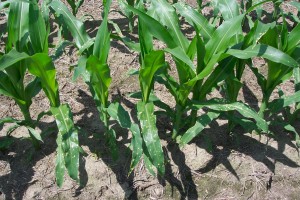Early Season Corn Management Adjustments Due to Frequent or Excessive Rainfall
go.ncsu.edu/readext?411679
en Español / em Português
El inglés es el idioma de control de esta página. En la medida en que haya algún conflicto entre la traducción al inglés y la traducción, el inglés prevalece.
Al hacer clic en el enlace de traducción se activa un servicio de traducción gratuito para convertir la página al español. Al igual que con cualquier traducción por Internet, la conversión no es sensible al contexto y puede que no traduzca el texto en su significado original. NC State Extension no garantiza la exactitud del texto traducido. Por favor, tenga en cuenta que algunas aplicaciones y/o servicios pueden no funcionar como se espera cuando se traducen.
Português
Inglês é o idioma de controle desta página. Na medida que haja algum conflito entre o texto original em Inglês e a tradução, o Inglês prevalece.
Ao clicar no link de tradução, um serviço gratuito de tradução será ativado para converter a página para o Português. Como em qualquer tradução pela internet, a conversão não é sensivel ao contexto e pode não ocorrer a tradução para o significado orginal. O serviço de Extensão da Carolina do Norte (NC State Extension) não garante a exatidão do texto traduzido. Por favor, observe que algumas funções ou serviços podem não funcionar como esperado após a tradução.
English
English is the controlling language of this page. To the extent there is any conflict between the English text and the translation, English controls.
Clicking on the translation link activates a free translation service to convert the page to Spanish. As with any Internet translation, the conversion is not context-sensitive and may not translate the text to its original meaning. NC State Extension does not guarantee the accuracy of the translated text. Please note that some applications and/or services may not function as expected when translated.
Collapse ▲Nutrient Correction (Nitrogen and Sulfur)
Potential yield is determined early within the development of a corn plant. The number of rows that develops is largely based upon genetics but can be reduced by stresses to the plant. Likewise, the potential number of kernels per row develops from about the 6th-7th leaf stage through about one week prior to silk emergence. Thus, any stress during this early growth has the potential to reduce yield.
Regrettably, within Craven County, NC, soil types and frequent rainfall may result in early season water stress to corn plants. Heavy rainfall events that leave the soil water saturated reduce oxygen to the plant roots and may also leach nitrogen (N) and sulfur (S). Since coarse sandy soils are inherently low in S and have a low nutrient holding capacity, the lower soil S content may also reduce nitrogen uptake. In contrast, soils with a higher silt content or high organic matter may seal or simply remain water saturated leading to loss of N from denitrification. In both cases, the nutrients may need to be replaced to prevent potential yield reduction once soil saturated conditions are remedied.
Typically, N deficiency of corn plants shows as pale yellow color on bottom leaves. A deficiency in S may result in an overall pale green to yellow appearance of the entire plant or in some case may result in interveinal chlorosis. In this particular example, both N & S deficiency symptoms are present.
Factors affecting the rate to apply as a corrective measure should include corn growth stage, price of product, and management priorities. Current N management recommendations for corn are to split applications of N. A small amount of N is usually provided at planting (20-40 lbs./ac of actual N) to supply ample N for early growth. However, the majority of N is applied much later in the season to coincide with the greatest N demand of the corn plant. This also reduces the chance that N will be lost to leaching or denitrification due to excessive rainfall, protecting both potential profit and the environment.
Typically, most early season corrective actions seldom require more than 20-40 lbs./ac of actual N. For best results, sulfur should be added to facilitate N uptake on mineral soils. (Ideally, the plant tissue ratio of N to S should be 15:1). This corrective measure can be easily and inexpensively accomplished by broadcast application of 100-150 lbs./ac of an ammonium sulfate product or 10-15 gallons/ac of a liquid N solution with sulfur (rate depends upon N concentration of liquid product).
Under normal circumstances, these corrective actions for early season N or S deficiency should result in adequate N & S to encourage rapid plant growth. Should yellowing plants or leaves persist more than 7-10 days after corrective measures have been applied, it is likely that some other problem exists. Other common causes of yellowing leaves or stunted growth include low manganese, low copper, low soil pH, nematode problems, insect damage or herbicide injury. Often symptoms for these potential problems are remarkably similar and cannot always be distinguished by visual observation. Thus, it is strongly suggested to submit plant tissue, soil samples and nematode samples for analysis to the North Carolina Department of Agriculture & Consumer Services Agronomic Division prior to taking any additional corrective actions. Information on proper leaf sampling procedure, costs, and other instructions for taking these samples is found at http://www.ncagr.gov/agronomi/. Too, images sent directly to the local N.C. Cooperative Extension may also provide some insight. (Find your local NC Extension Office HERE https://www.ces.ncsu.edu/local-county-center/
Early Season Weed Management
With the advance of herbicide tolerant crops, weed control has become a bit easier….at least in theory. Frequent rainfall that prevents entry into the field allows weeds to grow rapidly. These large weeds not only reduce yield, they usually require higher rates of herbicide to control. Higher rates of product increases total production cost to further reduce potential profit. The point is, aim to apply weed control as soon as warranted. Include products that also provides good residual control. This is especially critical given the glyphosate- ALS resistant Palmer amaranth (pigweed) common to this area. A complete list of products available within NC for weed control is found at (insert web page here) http://content.ces.ncsu.edu/north-carolina-agricultural-chemicals-manual/chemical-weed-control
Your Worst Enemy is Often YOU
Failure to properly clean spray equipment, drift, temperature inversions…..or just carelessness, may result in unwanted herbicide products on corn. Such is the case in the image to the left. Gramoxone™ applied as a burndown product in preparation of planting soybeans in a nearby field drifted into the corn field. Fortunately, as in most cases, this leaf damage appearance is worse than actual damage to the corn plant itself. However, it is a reminder that one should use caution when applying products. Read and follow all pesticide label directions.
Micronutrients
As mentioned earlier within the article, low manganese (Mn) or copper (Cu) may also result in pale green to yellow leaves, interveinal chlorosis of the leaves, and stunting. Visually, both may appear identical. Tissue analysis and soil test results must be used to diagnose proper corrective action. Fortunately, both Mn and Cu may be applied either as granular or foliar products to correct deficiencies at relatively low rates. In severe cases, multiple applications may be necessary. These foliar applications are a great remedial treatment but will not provide enough of the element to correct the inherent low soil Mn or Cu levels. Thus, greater rates (based upon soil test results) that provide a more long-term benefit will need to be applied prior the next planting season.
Nematodes & Disease
Many types of nematodes may affect corn growth. Early detection and crop rotation are the most economically feasible management option. (Fumigants and in-furrow nematicides are indeed options but current corn commodity prices do not reflect enough profit margin for serious consideration of these products within this area). Planning in advance to avoid nematode problems is the best option available. Discovery of nematodes at levels high enough to warrant crop damage after planting leaves no management options.
Email the author : mike_carroll@ncsu.edu
Follow the author on Twitter: @mcarroll_craven
Gramoxone is a registered trademark of Syngenta.
The use of brand names and any mention or listing of commercial products or services in this publication does not imply endorsement by the N.C. Cooperative Extension Service nor discrimination against similar products or services not mentioned. Individuals who use agricultural chemicals are responsible for ensuring that the intended use complies with current regulations and conform to the product label. Be sure to examine a current product label before applying any product.







